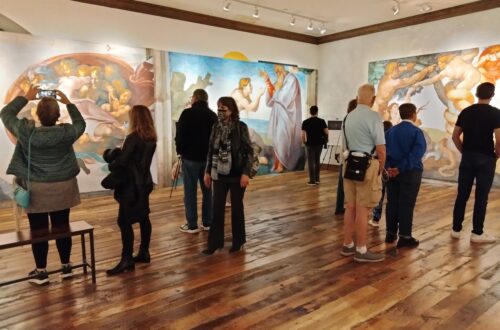-
Carapelle Calvisio

By Nancy DeSanti
Province of L’Aquila, Region of Abruzzo
The beautiful small town of Carapelle Calvisio is located in the natural park known as the Gran Sasso e Monti della Laga National Park. It has approximately 120 inhabitants, known as Carapellesi.
It is probably best known as the smallest community in Abruzzo and as being one of the smallest non-alpine comunes in Italy. Its territory was featured, along with Rocca Calascio, in a medieval fantastic movie, “Ladyhawke,” starring Michelle Pfeiffer.
It comprises a handful of stone houses perched at about 900 meters above sea level, among the wooded hills covered with oaks and pines, with a magnificent panoramic view of the Aquila basin up to the Maiella massif and the Navelli plain.
The village stands on one of the last southern reaches of the Gran Sasso massif and the historic center preserves, almost intact, its ancient urban structure of a medieval fortified village, with the houses leaning against each other and separated by narrow alleys that occasionally open into small spaces.
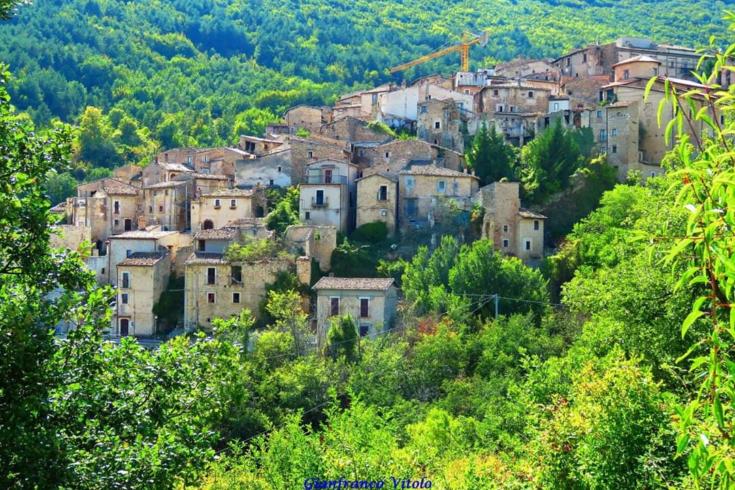
A view of the village of Carapelle Calvisio
Credit: Gianfranco VitoloThe area around Carapelle Calvisio has been inhabited since prehistoric times, as evidenced by the many finds dating back to the Paleolithic era. Initially occupied by the people of the Vestini, the area was then conquered by the Romans around the 4th century B.C., after the defeat of the Samnites. With the fall of the Roman Empire, the population moved to the hills and found shelter inside a fort and monasteries.
Despite or maybe because of its small size, the history of Carapelle Calvisio has been troubled. Starting from the 12th century, Carapelle was referred to as a Castrum, that is, as a fortified village. In 1273, Charles I of Anjou conquered this part of Italy, definitively defeating the Swabians. The Angevins put Carapelle Calvisio among the territories of a new barony. At the end of the 1300s, the Angevin ruler Charles III of Durres granted the barony in fiefdom to Peter, Count of Celano.
In following years, the castle was reinforced and nowadays traces of the ancient fortress can be found in the highest part of the town.
Later the Spanish kings of Aragon arrived and the barony was assigned first into the hands of Antonio Piccolomini and then Ottavio Cattaneo. During the Renaissance period, the Church of Saint Francis was established and embellished with frescoes.
In 1579, the territory was under the dominion of the Medici, Grand Dukes of Tuscany, who created the Medici State of Abruzzo to ensure the supply of the fine Carfagna wool, produced by local sheep. This is a fine dark-colored wool with which they made the military uniforms and robes of the monks.
With the Medici and the wool trade, the town went through a period of relative prosperity. Churches were embellished and Palazzo Piccioli was placed in the center of the town.
Like many Abruzzo territories, Carapelle Calvisio also saw many of its inhabitants emigrate in search of fortune after the unification of Italy and after the World Wars. And unfortunately, the village was seriously damaged by the 2009 L’Aquila earthquake.
The most valuable agricultural products in the area are cheeses, sheep meat, olive oil, saffron and especially truffles, which in ancient times were discovered with the use of trained pigs.
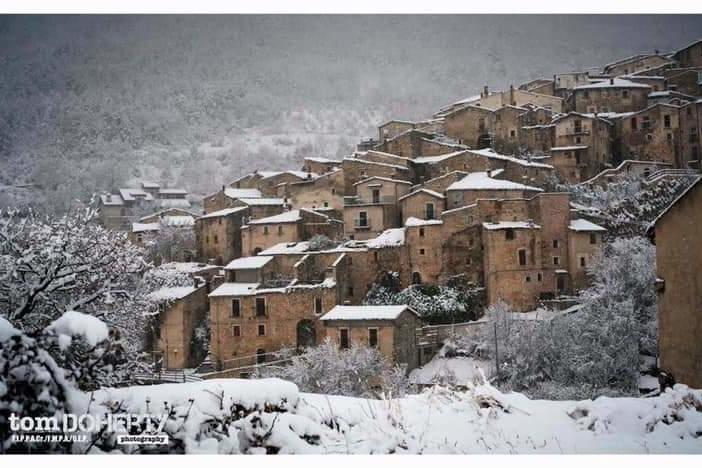
A view of Carapelle Calvisio in the winter
Credit: Tom Doherty PhotographyOne of the characteristic dishes is fried figs, used to season savory dishes such as pasta and eggs, while among the desserts there is the ferratelle (waffle cookies), prepared for the feast of the patron saint, San Pancrazio.
Visitors to the area describe it as a magical place to visit, steeped in the past, and as a starting point to discover the Gran Sasso National Park, which has been described as one of the most beautiful parks in Italy.
After a first wave of emigration started towards the United States, at the time of World War I, a second large emigration followed in the 1950s. Canada, France and Australia were the main destinations. Nowadays in Toronto, there is a Carapellese community five times the present population of the village.
What to See
- The historical center
- The church of St. Francis of Assisi, decorated in the baroque style with beautiful frescoes
- The Shrine of St. Pancrazio.
Important Dates
- May 12 – Feast of St. Pancrazio, the patron saint
- August 15 – Feast of Emigrants
Italiano

Tradotto da Ennio Di Tullio
Provincia di L’Aquila, Regione Abruzzo
Il bellissimo paesino di Carapelle Calvisio si trova nel parco naturale noto come Parco Nazionale del Gran Sasso e Monti della Laga. Conta circa 120 abitanti, detti Carapellesi.
Probabilmente è meglio conosciuta come la più piccola comunità in Abruzzo e come uno dei più piccoli comuni non alpini d’Italia. Il suo territorio è stato protagonista, insieme a Rocca Calascio, in un fantastico film medievale, “Ladyhawke”, con Michelle Pfeiffer.
Si compone di una manciata di case in pietra arroccate a circa 900 metri sul livello del mare, tra le colline boscose ricoperte di querce e pini, con una magnifica vista panoramica sulla conca dell’Aquila fino al massiccio della Maiella e alla piana di Navelli.
Il paese sorge su uno degli ultimi lembi meridionali del massiccio del Gran Sasso e il centro storico conserva, pressoché intatta, l’antica struttura urbanistica di borgo fortificato medioevale, con le case addossate l’una all’altra e separate da stretti vicoli che di tanto in tanto si aprono in piccoli spazi.
Il territorio intorno a Carapelle Calvisio è stato abitato fin dalla preistoria, come testimoniano i numerosi reperti risalenti al Paleolitico. Inizialmente occupata dal popolo dei Vestini, la zona fu poi conquistata dai Romani intorno al IV secolo a.C., dopo la sconfitta dei Sanniti. Con la caduta dell’Impero Romano, la popolazione si trasferì in collina e trovò rifugio all’interno di un forte e di monasteri.
Nonostante o forse proprio per le sue ridotte dimensioni, la storia di Carapelle Calvisio è stata travagliata. A partire dal XII secolo Carapelle fu indicata come Castrum, cioè come borgo fortificato. Nel 1273 Carlo I d’Angiò conquistò questa parte d’Italia, sconfiggendo definitivamente gli Svevi. Gli Angioini collocarono Carapelle Calvisio tra i territori di una nuova baronia. Alla fine del 1300 il sovrano angioino Carlo III di Durazzo concesse la baronia in feudo a Pietro, conte di Celano.
Negli anni successivi il castello fu rinforzato e oggi tracce dell’antica rocca si trovano nella parte più alta del paese.
Successivamente arrivarono i re spagnoli d’Aragona e la baronia fu assegnata prima ad Antonio Piccolomini e poi a Ottavio Cattaneo. In epoca rinascimentale fu eretta la Chiesa di San Francesco, abbellita con affreschi.
Nel 1579 il territorio passò sotto il dominio dei Medici, Granduchi di Toscana, che crearono lo Stato Medici d’Abruzzo per garantire l’approvvigionamento della pregiata lana Carfagna, prodotta dalle pecore locali. Si tratta di una pregiata lana di colore scuro con cui si confezionavano le divise militari e le vesti dei monaci.
Con i Medici e il commercio della lana, il paese visse un periodo di relativa prosperità. Furono abbellite le chiese e al centro del paese fu collocato Palazzo Piccioli.
Come molti territori abruzzesi, anche Carapelle Calvisio ha visto molti dei suoi abitanti emigrare in cerca di fortuna dopo l’Unità d’Italia e dopo le Guerre Mondiali. E purtroppo il paese è stato gravemente danneggiato dal terremoto dell’Aquila del 2009.
I prodotti agricoli più pregiati della zona sono i formaggi, la carne di pecora, l’olio d’oliva, lo zafferano e soprattutto i tartufi, che anticamente venivano scoperti con l’utilizzo di maiali allevati.
Uno dei piatti caratteristici sono i fichi fritti, usati per condire pietanze salate come pasta e uova, mentre tra i dolci vi sono le ferratelle, preparate per la festa del patrono San Pancrazio.
I visitatori della zona lo descrivono come un luogo magico da visitare, ricco di passato, e come punto di partenza per scoprire il Parco Nazionale del Gran Sasso, che è stato definito uno dei parchi più belli d’Italia.
Dopo che iniziò una prima ondata di emigrazione verso gli Stati Uniti, all’epoca della prima guerra mondiale, seguì negli anni ’50 una seconda grande emigrazione. Canada, Francia e Australia sono state le destinazioni principali. Oggi a Toronto c’è una comunità carapellese cinque volte la popolazione attuale del villaggio.
Attrazioni del luogo:
- Il centro storico
- La chiesa di San Francesco d’Assisi, decorata in stile barocco con bellissimi affreschi
- Il Santuario di San Pancrazio
Date da ricordare:
- 12 maggio – Festa di San Pancrazio, patrono
- 15 agosto – Festa degli Emigranti
Sources: https://en.wikipedia.org/wiki/Carapelle_Calvisio
https://www.italyheritage.com/regions/abruzzo/laquila/carapelle.htm
https://discoverplaces.travel/en/Places2/guide-to-carapelle-calvisio/May/June 2022
-
Siamo Una Famiglia
More AMHS Members Recall Their Roots in Bugnara
By Nancy DeSanti

View of the Gran Sasso in Abruzzo
Credit: TripAdvisor
Readers may recall that the March/April Notiziario featured an article on the Abruzzese town of Bugnara, recounting how AMHS member Willy Meaux recently bought a farmhouse and some land in his grandfather’s hometown so he and his wife, Mary Bernard, can retire there someday. From the front door of his farmhouse, Willy can see the beautiful Gran Sasso.
But Willy is not the only AMHS member with ties to the town. Mario Marinucci’s late father, Cristino, as well as his father’s brothers, Rosario and Vince (Mario’s uncles), and his father’s sisters, Elia and Gilda (Mario’s aunts), are from the town.
And Gino Marinucci said his connection to Bugnara is that his home is two miles from the paese. From his bedroom window, he said he can see the entire town crested on the side of the mountain west southwest of him. He noted that Bugnara is roughly 5 miles from Sulmona and he lives about halfway down the road which the Bugnaresi use to go to Sulmona, a much bigger city.
Gino noted that his first cousins, Cristino (Mario’s father) and Gilda (Mario’s aunt), lived next door to him. Gino said the house was like a duplex and he had to walk past their front door to access his house, commenting, “You can’t get much closer than that.”
Last but not least, AMHS Past President Omero Sabatini said that his mother, Carmela, when she was still single, had worked as a midwife at Bugnara. There, he said, she was known as ostetrica condotta (He noted that in Italy, an obstetrician is called ostetrico or ostetrica). Omero said, “Given the Italian tendency to inflate titles, a midwife is often called ostetrica, even though in the old days she only had two years of specialized training.” Omero added that condotta means that she was an employee of the municipality. As such, he said she could charge no fee to women on relief (sull’elenco dei poveri), but charged a fee determined by law to all other women; the amount varied depending on the economic resources of the mother.
Omero noted that in the dialect of some parts of Abruzzo, babies are not delivered. They are picked up. Omero said that many people had told him, “Your mother picked me up.” He said his mother always spoke with nostalgia about her years in Bugnara. Being young, single and beautiful, Carmela, according to Omero, was courted by every eligible man in town, but she married one from her own village of Secinaro and said goodbye to Bugnara. “Thank God,” says Omero, “or I would not be on this earth.”
May/June 2022
-
GWU’s Italian Society Holds First Annual Spring Gala Italiana
AMHS Board Member Julia Paola, who is a past recipient of an AMHS Scholarship Award and President of George Washington University’s Societa’ di Cultura Italiana, submitted this report on the society’s first annual Spring Gala

The GWU Societa’ di Cultura Italiana honored professors of Italian for their support. AMHS Board Member and student organization President Julia Paola (2nd from right) thanked (L to R) Professors Alessandra
Harness, Antonella Longoni and Lynn Westwater.
Credit: Vittoria FerrariOn March 5, GWU’s Societa’ di Cultura Italiana held its first annual Spring Gala with great success. This event represented an achievement in many different areas of my life and in the history of the club. Covid-19 forced us online between March 2020 and September 2021, but this school year, we were finally able to begin in-person events with restrictions. The gala was our first major event since February 2020 and we had the largest turnout our club has ever had during my four years at GW with over 130 people in attendance. We could not have imagined this event going any better and are so happy that everyone enjoyed the food from local Italian restaurants and socializing throughout the evening.
I dreamed of organizing a gala for the club since I was a Freshman representative in 2018 and with the help and dedication of the club’s Executive Board, we were able to finally host it. The aim of this event was to drive cultural awareness and celebrate the influence of Italians on the United States and our modern traditions and allow students to partake in a bit of ‘cultura italiana‘. Thanks to our great sponsors, we had a sampling of Italian foods and giveaways from local businesses to foster a sense of community between our students and D.C. Our sponsors included Toscana Market, Il Canale, San Lorenzo, La Tomate, Al Dente, Capo Deli, Dolci Gelati, Carmine’s and NIAF. We truly cannot thank them enough for the amazing food, cookbook, and gift cards they donated to make our event a success.
The aim of this event was to drive cultural awareness and celebrate the influence of Italians on the United States and our modern traditions and allow students to partake in a bit of ‘cultura italiana‘.
The gala was in time for Festa della Donna and International Women’s Day on March 8and honored some important women. Our Italian department at GW is small, but mighty, and happens to be made up of all female professors. Antonella Longoni, Lynn Westwater, Paola Warfield, and Alessandra Harness were each given a small bouquet of Mimosa flowers and personalized notebook during the ceremony. They have crafted amazing classes on a vast number of topics, worked diligently to spread the Italian language, and supported our club, and especially me, over the past four years. The final honoree was AMHS’ own Maria D’Andrea-Yothers. She was honored at the AMHS meeting on March 27th for supporting me during my internship with the Society in my freshman year and providing many opportunities to continue to grow my involvement in D.C.’s Italian community. Thanks to her, I continued my involvement with the AMHS and am now fortunate enough to participate on the Board of Directors. These women go above and beyond to help students interested in this amazing culture and we could not be more grateful.
Overall, the gala was an extremely meaningful event for GW’s Italian club and a great note to end on for my time at the university. I truly could not have been more surprised by how many people wanted to attend and the businesses that were so generous to donate to us to help us put on this event. We know these past two years have been challenging for everyone, which made their efforts even more appreciated. I feel like I left my mark on GW, and I cannot express how much this event meant to me. Though I am graduating in May, I hope this gala continues as an annual event to help foster connections between Italian students, those interested in Italian, and the local community of Italian businesses and restaurants.
May/June 2022
-
A Message from the President

Dear members and friends:
We are now well into spring and, after a slow start, the weather has finally come along too. Baseball, after resolution of its labor issues, has resumed and has helped to make the season look familiar. I hope that you are enjoying it.
Our Society welcomed the spring with its first in-person event of the year. It took place on March 27 at Casa Italiana and was co-sponsored by the Casa Italiana Sociocultural Center (CISC) and the Casa Italiana Language School (CILS). It featured as guest speaker the author and tour guide Carla Gambescia, who spoke on the “A to Z of Italian Culture.” Carla gave an entertaining and informative presentation in which those in attendance could test their knowledge on some lesser-known aspects of Italian culture. She also had available copies of her book “La Dolce Vita University: An Unconventional Guide to Italian Culture from A to Z”, which she graciously signed for any buyer interested. Before the presentation, attendees, numbering over 80, enjoyed an outstanding meal prepared by the restaurant A Modo Mio. One of our notable guests, Fr. Sergio Dall’Agnese, pastor of Holy Rosary Church (HRC), delivered a special blessing over the food that very much fit the occasion and added a special touch to the meal and to the day. Other special guests included: Fr. Peter Paul Polo of HRC; Maria Fusco, Director of Education at the Italian Embassy; Vicki Cooper, who has been instrumental in setting up funding for a new scholarship that will be paired with the AMHS traditional scholarships, and Mary Ann Re, a new member of the CISC Board of Directors.
The event was also the occasion of our first spring merchandise sale, in which members, friends and guests were able to purchase totes, hats, shirts, aprons, and cookbooks with the AMHS logo. We sold over $200 worth of merchandise – our most successful sale to date. A little later this year our online shop, accessible from our website, will be up and running, with well over 100 products available for purchase. Stay tuned for more information.
On April 3, a group of AMHS members and friends traveled to Tysons Corner Center, Virginia to view a Michelangelo Sistine Chapel Exhibition. The exhibition used state-of-the-art technology to give viewers the same close-in perspective that Michelangelo would have had and that travelers to the Vatican simply cannot get. After enjoying this rare opportunity, the group went to lunch at the Italian Oven restaurant in McLean.
Mark your calendars for our next in-person event, which will take place at 1 p.m. on May 15 at Casa Italiana. Amy Riolo, a best-selling author, chef, TV personality and culinary expert, will be our guest speaker and will moderate a panel discussion of well-known chefs and Italian food industry notables. If you are interested in Italian cuisine, Italian cooking and Italian products, you should reserve your spot for what will be a very interesting afternoon.
The AMHS Scholarship Committee has finished its evaluation of this year’s applicants for the academic year 2022-2023 scholarships. The Society will announce the winners in a later edition of this Notiziario. These scholarships are funded exclusively through your donations, and we thank you for your generosity and commitment to the mission of preserving our Italian heritage and passing on an appreciation of it to those coming after us.
Have a wonderful spring.
Regards,
Ray LaVerghetta
May/June 2022
-
Cercemaggiore

By Nancy DeSanti
Province of Campobasso, Region of Molise
The ancient town of Cercemaggiore is located about 12 kilometers southeast of Campobasso. It has approximately 3,717 inhabitants known as Cercesi.
The name derives either from Quercus Maior (meaning big oak) or from the Arabic “cerce,” meaning “rock.” It has been inhabited since pre-historic times, then was a center of the Samnites, a fierce, warlike Italic people who fought courageously against the Romans before being conquered. The town was also occupied by the Saracens and later, in the 11th century, by the Normans. All these various populations left their traces in the monuments and the culture. Nowadays the town is a favorite starting point for those who love trekking and horseback riding along the ancient tratturi of the Sannio.
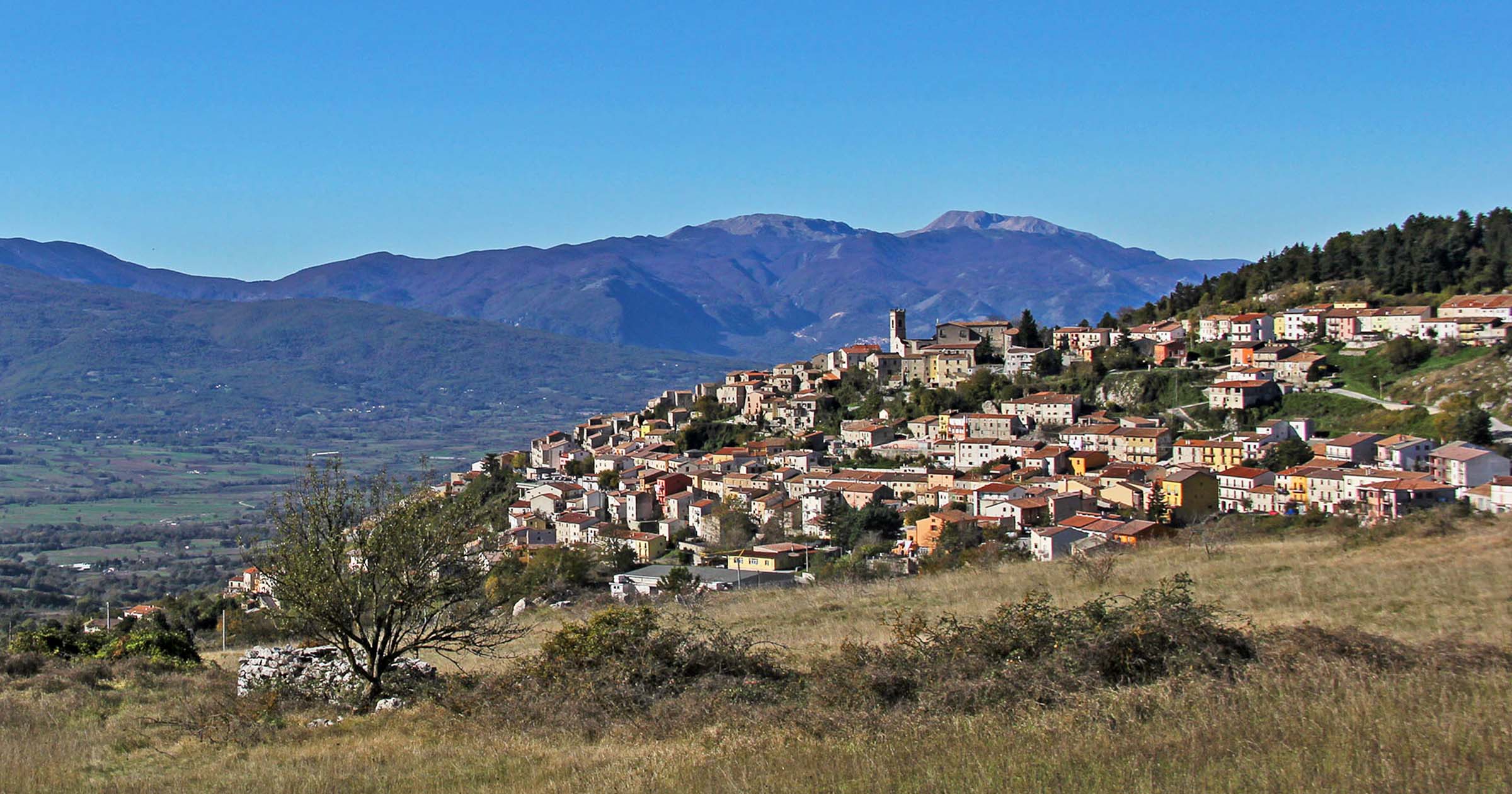
Panoramic view of Cercemaggiore
Credit: Turismo in MoliseFrom its elevated position, Cercemaggiore overlooks the Tammaro Valley, the Matese and the Majella, and southwards as far as the Mountains of the Salerno area. One of the main attractions of Cercemaggiore is the parish Church of Santa Maria della Croce, restored in the late 16th century and again after an earthquake in 1807. The church features paintings by Benedetto Brunetti from Oratino, a 17th century painter. Other places of interest are the Castle and also the Church of Santa Maria da Monte, on the top of the nearby Monte dell’Assunta. The church was built on the site of a pagan temple.
Also worth seeing is the Church of Santa Maria della Libera, located 2 kilometers from the town. The church was built in 1412 in the Romanesque style and has been a favorite destination of pilgrims, containing fine works of art, such as a wooden statue of San Vincenzo Ferreri made in the 18th century by Paolo Saverio di Zinno from Campobasso. Visitors can also see a painting of Madonna di Costantinopoli by Tommaso Guarino; as well as another painting of the Virgin Mary and Saints from, 1612, made by Sebastiano Pasquale from Capua. Near the altar are two impressive ancient Roman stone lions.
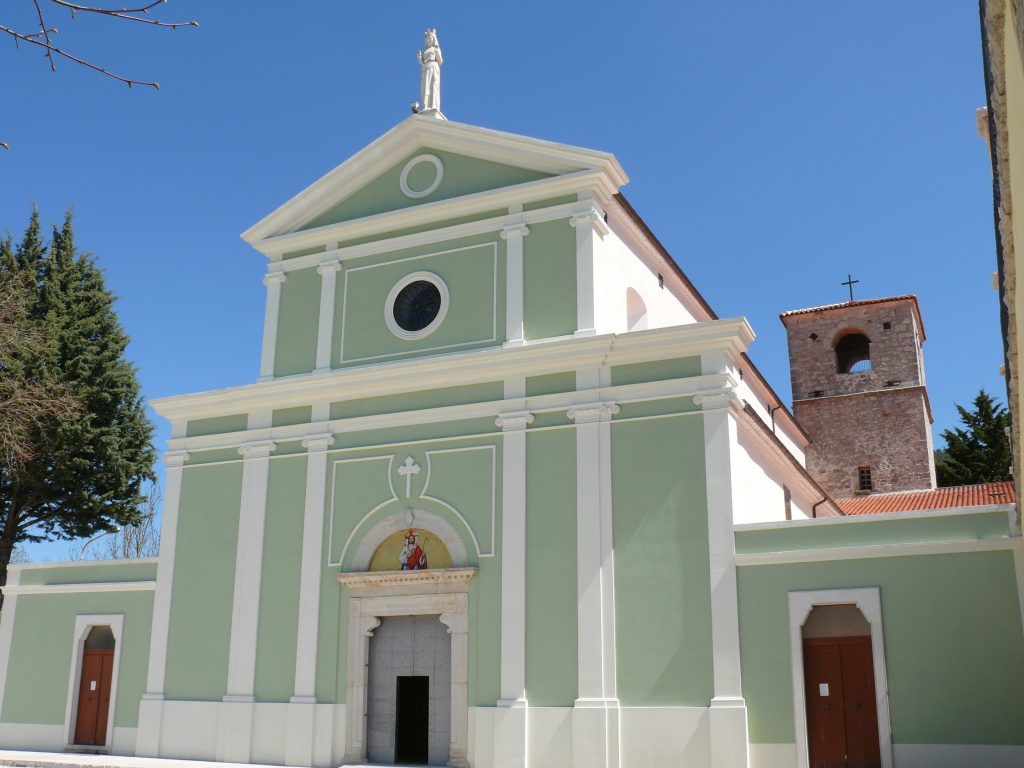
Church of Santa Maria della Libera
Credit: Primo Piano MoliseWhat to See
- Church of Santa Maria della Croce
- Church of Santa Maria da Monte
- Church of Santa Maria della Libera
- Castle
- Summit of Monte Saraceno, with a wide view on the surrounding areas
Important Dates
- September 11 – Feast of San Vincenzo, the patron saint
Italiano

Tradotto da Ennio Di Tullio
Provincia di Campobasso, Regione Molise
L’antica città di Cercemaggiore si trova a circa 12 chilometri a sud est di Campobasso. Conta circa 3.717 abitanti conosciuti come Cercesi.
Il nome deriva o da Quercus Maior (che significa grande quercia) o dall’arabo “cerce”, che significa “roccia”. Abitato fin dalla preistoria, fu poi centro dei Sanniti, popolo italico feroce e bellicoso che combatté coraggiosamente contro i Romani prima di essere conquistato. Il paese fu occupato anche dai Saraceni e successivamente, nell’XI secolo, dai Normanni. Tutte queste varie popolazioni hanno lasciato le loro tracce nei monumenti e nella cultura. Oggi il paese è un punto di partenza privilegiato per gli amanti di escursionismo e delle passeggiate a cavallo lungo gli antichi tratturi del Sannio.
Dalla sua posizione elevata Cercemaggiore domina la Valle del Tammaro, il Matese e la Majella, e a sud fino ai Monti del Salernitano. Una delle principali attrazioni di Cercemaggiore è la Chiesa parrocchiale di Santa Maria della Croce, restaurata alla fine del XVI secolo e nuovamente dopo un terremoto nel 1807. La chiesa conserva dipinti di Benedetto Brunetti da Oratino, pittore del XVII secolo. Altri luoghi di interesse sono il Castello e anche la Chiesa di Santa Maria da Monte, sulla sommità del vicino Monte dell’Assunta. La chiesa fu costruita sul sito di un tempio pagano.
Da vedere anche la Chiesa di Santa Maria della Libera, situata a 2 chilometri dal paese. La chiesa fu edificata nel 1412 in stile romanico ed è stata meta prediletta dei pellegrini, custodisce pregevoli opere d’arte, come una statua lignea di San Vincenzo Ferreri realizzata nel XVIII secolo dal campobassano Paolo Saverio di Zinno. I visitatori possono inoltre vedere un dipinto della Madonna di Costantinopoli di Tommaso Guarino; oltre ad un altro dipinto della Madonna e Santi del 1612, opera del capuano Sebastiano Pasquale. Vicino all’altare ci sono due imponenti leoni di pietra dell’antica Roma.
Attrazioni del luogo:
- Chiesa di Santa Maria della Croce
- Chiesa di Santa Maria da Monte
- Castello
- Sommità del Monte Saraceno
Date da ricordare:
• 11 settembre – Festa di San Vincenzo, patrono
Sources:
https://en.wikipedia.org/wiki/Cercemaggiore
https://www.italyheritage.com/regions/molise/province-campobasso/cercemaggiore.htm
https://www.italymagazine.com/cercemaggioreMay/June 2022







